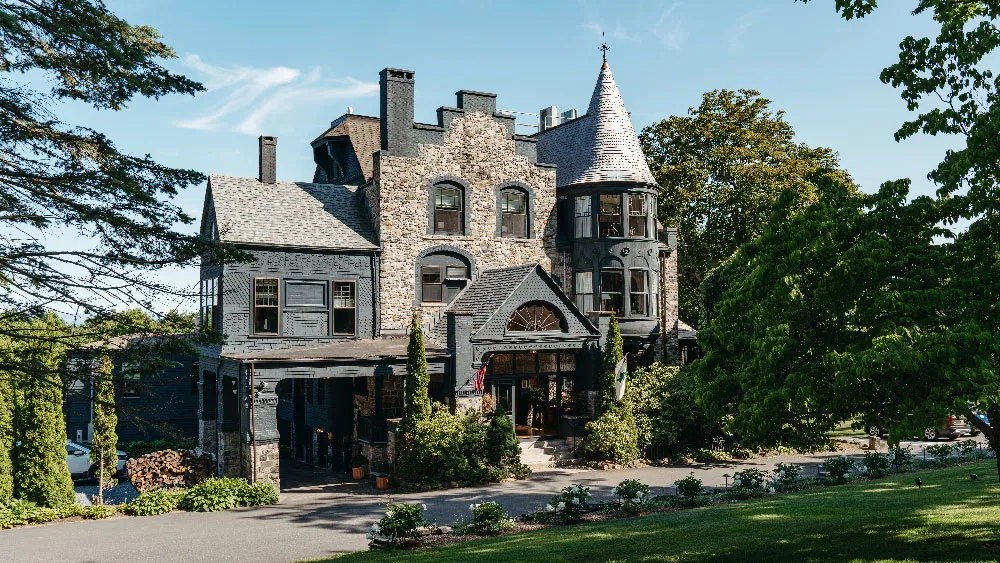March 18, 2016
From Dining Room to Dungeon: Tom House
Dale Pauly READ TIME: 7 MIN.
Just as no man who's ever lived is as central to gay fetish culture as Tom of Finland, no building is as important to preserving its heritage and fostering its future as Tom House, the artist's one-time Los Angeles home and studio located in the city's Echo Park neighborhood. Now a living, breathing, throbbing homage to male erotic art, the century-old Craftsman home has finally been given a gorgeous and appropriately raunchy book of its own.
Released earlier this month from Rizzoli, "Tom House: Tom of Finland in Los Angeles," is a no-holds-barred volume that manages to deftly blend the iconic sex-positive art of Tom of Finland, beautiful original photographs of Tom House and its gardens, and a fascinating history of Tom the man, his American home base, and his relationship with model and mega-male muse Durk Dehner.
EDGE spoke to Dehner, who's lived at Tom House since 1979 and is the president of the Tom of Finland Foundation that's headquartered here, as well as Michael Reynolds, the book's creative director and the U.S. editor of Wallpaper* magazine.
A Legacy Endures
Many books have explored Tom of Finland and his art over the years. And why did you think Tom House deserved a book of its own?
Michael Reynolds: A number of books have been published about the life of Touko Laaksonen [aka Tom of Finland, 1920-1991] and his artwork, but never one like this. This book is a triple threat. Not only does it photographically document the interiors, exteriors and gardens of one of the most iconic homoerotic artists of the 20th century, but it boldly weaves in a substantial number of never-before-published preparatory drawings by the artist and is accompanied by a brilliantly written essay [written by Mayer Rus, West Coast editor for Architectural Digest] that explores the profoundly close, magical relationship between the artist and Durk Dehner.
Durk, do you think Tom would be surprised by the enduring legacy of not just his art, but of Tom House as well?
Durk Dehner: Tom would be pleasantly surprised, of course. He always would aim for the improbable to the impossible, and was frequently amazed how that would transform into reality. It started with our mission statement for the foundation in protecting, preserving and promoting works that were erotic in their nature.
Today the foundation continues in its efforts of educating the public as to the cultural merits of erotic art and in promoting healthier, more tolerant attitudes about sexuality. As soon as we expanded the foundation's purpose to include his fellow artists, that was where it truly began to thrive and become a center -- a gathering spot for the appreciation of each other's works and the development of value associated with the actual works themselves, which was the living embodiment of Tom's ethics.
It gradually evolved, becoming more and more a place for artists and those who appreciated works that were sexual in their expressions. The house has become a bit of everyone and everything it contains: a celebration of the culture of homosexuals in all its diversity.
The Essence of Tom House
How would you sum up Tom House in just a sentence or two for a young gay guy who knew nothing about it?
DD: Imagine a place that celebrated your nature, offering up visuals of yourself as you see yourself; conjuring up your urges, cravings and desires without any shame, guilt or judgment; evoking a fully spirited, culturally rich, well-rounded homosexual, that being you. That is Tom House. It is also one place on earth where you will have a sense of belonging, paying homage to your base animal nature and the deepest spiritual sense of yourself as a being.
It has massive amounts of art and memorabilia of our culture, past and present, and is a place where artists, scholars and the visiting public can access and submerge themselves in our rich heritage from hundreds of fellow artists spanning many past decades of the culture of our tribe. It's a place that you might think about leaving some of your spunk behind to add to the overwhelming essence of a place you would call yours.
Michael, do you think gay historic and cultural architecture could be a burgeoning niche, or is Tom House completely unique in that regard?
MR: I'm not sure that Tom House is the first book to ever serve up a heaping plate of gay historic culture and personal decor, but it is -- in my opinion -- unique in the graphic nature of the content and the politics of its visual message. Art versus obscenity is an age-old debate, yet one that seems to be once again in vogue. I wanted this book to challenge the viewer's sense of propriety. I like to think of it as a coffee table book with balls, literally and figuratively - a conversation piece! Not just another fluffy, bourgeois, pathetically aspirational interiors book.
How did you choose the photographs and art for the book?
MR: The interior, exterior and garden photography, aside from some of the vintage imagery, was shot specifically for the book by Martyn Thompson. In the end, we published each and every photograph that was taken. For the art, we edited through close to 1,800 preparatory drawings and chose roughly 100 that we considered to be the strongest for our purposes - drawings that we felt would create powerful juxtapositions when paired with the photography.
Was Anything Off Limits?
Did the book's publisher, Rizzoli, have any qualms about the subject matter? Was anything off limits for the book?
MR: Rizzoli completely championed the creation of this book and gave us an incredibly long leash regarding its content, image selection, text and design. We had their complete support, and it made all the difference. It was almost as though they intuitively knew that interference of any kind in the form of visual censorship or sanitizing the text would destroy the power of the book's message. There was an unspoken agreement that in order for Tom House to be authentic, it needed to be sensational, strong and unapologetically graphic.
Tom House has already served many roles: a living historical monument, a repository of erotic art, a sex-positive gathering place, a refuge for artists and at-risk youth and a site for memorials. Do you see its functions changing or evolving going forward?
DD: It's very organic and continues to evolve and transform in its expressions, being and serving the needs and desires of its visitors and explorers. It presently is becoming a special place for weddings and unions; it's a place for artists in residence; it offers live drawing classes; it's a perfect spot for visiting artists to hold receptions and lectures; and film nights showcase our vast 8mm film archive.
One thing that is for sure, Tom House feeds off of its visiting public, and it appears that every visitor somehow adds to the collective energy that makes the house and gardens that special place. Mind you, it's always a bit undone, and that's maybe why it never is completed and always is transforming. It's without restraints on what it can be.






